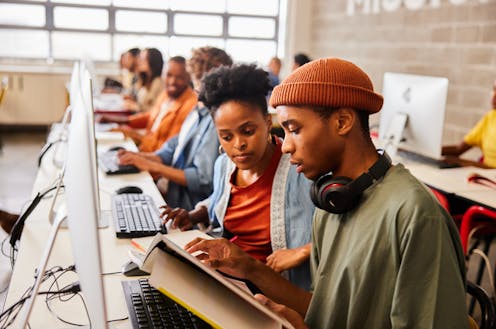How going back to the SAT could set back college student diversity
A few Ivy League schools say the tests enable them to find students of promise from low-income families. But not all sociologists agree.

Earlier this year, a number of colleges announced they were going back to using the SAT and the ACT. Here, Joseph Soares, a professor of sociology, expert on higher education and proponent of test-optional admissions, answers a few questions about the rationale behind the colleges’ decision to require applicants to submit scores from standardized college admissions tests.
Are SAT requirements making a comeback?
No. As of early 2024, just four schools announced the return of mandatory testing: Brown, Dartmouth, Yale and MIT.
Meanwhile, many other schools are sticking with test-optional admissions. These schools include Boston University, Columbia University, Cornell University, the University of Michigan, the University of Missouri system, the University of Utah, Vanderbilt University and William & Mary.
Prior to the COVID-19 pandemic, in 2019, there were approximately 1,050 test-optional schools out of approximately 2,300 bachelor’s degree-granting institutions, not counting the four-year for-profit schools.
Today, in 2024, there are over 1,900 test-optional or test-free schools. Nationally, test optional is still the norm.
Why are these schools going back to it?
The four schools that have gone back to standardized tests had initially dropped their requirement because of the pandemic. The College Board put its test administrations on pause during the pandemic because testing sites could not host them.
Now, administrators at Yale and Dartmouth say that some students from low-income families were harmed by not submitting test scores. Their argument is that by submitting test scores, it would have enabled colleges to find youths of promise from low-income families. The assumption is that students from an under-resourced high school, without an abundance of extracurricular opportunities or AP courses, will perhaps have a strong test score that will signal their potential.
Does their story check out?
I don’t believe the facts support the claims being made by the four universities that decided to reinstate the SAT.
After going test optional, the Ivy League and MIT had more racial and economic diversity than ever before.
Taking 2018 as a pre-pandemic benchmark, when test requirements were more common, and 2022 as a year of test-optional admissions by these schools, we can see the largest increase in the Ivy League’s history in underrepresented Black and Hispanic students came while being test optional. In 2018, there were 72,654 undergraduates in the Ivies plus MIT; in 2022, there were 74,258 undergraduates, an aggregate increase of 1,604 students.
Black and Hispanic students accounted for 79% of the total growth. The number of Black and Hispanic undergraduates went up at those nine schools by a total of 1,261, according to my analysis of figures from the U.S. Department of Education’s Integrated Postsecondary Education Data System.
The number of Pell Grant students, who are widely treated as a proxy for students from low-income families, went up at six schools, remained the same at one and declined slightly at two, my unpublished analysis found. This suggests that the numbers of students from low-income families also increased overall, although not on the same scale as increases in Black and Hispanic students.
Furthermore, test-optional policies did not prevent students from submitting test scores. If a student believed their test score was a plus, they could have submitted it.
What research are the schools relying on?
Dartmouth has issued a study that explains why it decided to resurrect a test score requirement. It reported that being test optional produced a “35% increase in applications,” and that 31% of all enrolled students at Dartmouth were admitted without a test score.
Of those applicants evaluated without reference to a test score, they afterward were able to get scores for 19% of them. They found higher admission rates for disadvantaged students whose unknown SAT scores were actually under 1400 than those with scores above 1400 – 82% vs. 18%, respectively.
The school saw this as a bad policy because it believes that higher-scoring disadvantaged students will have higher GPAs and brighter careers than lower-scoring ones. It drew the conclusion that requiring all to submit a test score was better for quality admissions than allowing students to decide on their own whether to submit their scores.
What does all this mean for campus diversity?
When highly selective schools – some refer to these as “highly rejective” schools – went test optional, diversity went up on their campuses. My research suggests that the resumption of standardized tests will diminish the number of applications from Black and Hispanic students and from low-income families.
Black and Hispanic students face “disparate headwinds” in taking a test where race is the strongest single variable that predicts test scores. Students of color are more likely than others to not include test scores in their college applications.
The case for restoring test-optional admissions in the name of equity and diversity has been made by a coalition of Black, Hispanic and low-income students at Dartmouth. They pointed out that a test score requirement weights strongly against Black, Hispanic and students from low-income families. They called on college administrators to restore test-optional admissions.
Joseph Soares does not work for, consult, own shares in or receive funding from any company or organization that would benefit from this article, and has disclosed no relevant affiliations beyond their academic appointment.
Read These Next
School shootings dropped in 2025 - but schools are still focusing too much on safety technology inst
Prevention methods like lockdown drills do not account for many scenarios, including the likely case…
The North Pole keeps moving – here’s how that affects Santa’s holiday travel and yours
There are actually two North Poles. One has been wandering over northern Canada and north of there for…
How rogue nations are capitalizing on gaps in crypto regulation to finance weapons programs
North Korea was behind a $1.5 billion digital bank heist in February 2025. Other countries are similarly…




